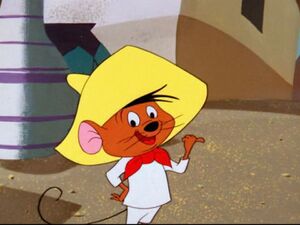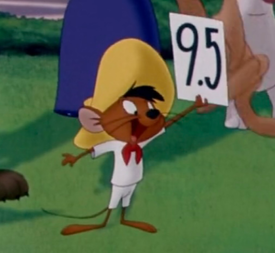Speedy Gonzales (character)
- This article is about the character, for other uses see Speedy Gonzales.
| Speedy Gonzales | |
|---|---|
 Mexico's favorite non-stereotype. | |
| Species | Mouse |
| Gender | Male |
| Member of | Tune Squad |
| Affiliation | Sylvester Daffy Duck Bugs Bunny Porky Pig |
| Occupation | Pizza shop owner in The Looney Tunes Show |
| Father | Not mentioned |
| Mother | Unnamed mother in The Looney Tunes Show |
| Cousin(s) | One cousin, Slowpoke Rodriguez |
| Marital status | Single |
| First appearance | MM: Cat-Tails for Two (1953) |
| Played by | Mel Blanc (1953-1989) Joe Alaskey (1990-2008) Greg Burson (1994) Eric Goldberg (2003) Billy West (2003) Bob Bergen (2006) Fred Armisen (2011-2015) Tim Dabado (2014) Eric Bauza (Since 2014) Dino Andrade (2018) Gabriel Iglesias (2021) Raul Ceballos (since 2023) |
 Robert McKimson's early Speedy | |
 Space Jam | |
| File:TLTS Speedy Gonzales.png The Looney Tunes Show | |
| File:NLTS Speedy Gonzales.png New Looney Tunes | |
| File:Space Jam New Legacy Speedy.png Space Jam: A New Legacy | |
Speedy Gonzales is an anthropomorphic mouse from Mexico, and a main character of the Looney Tunes & Merrie Melodies theatrical shorts. He is recognized in his home country as the "fastest mouse in all of Mexico," and is often hailed for his heroic deeds. His voice was originated by Mel Blanc using a Mexican accent.
Speedy first appeared in prototype form in the 1953 Robert McKimson short, Cat-Tails for Two. After a redesign in the 1955 short Speedy Gonzales, the character showed up in further theatrical shorts during the Golden Age of American animation, appearing in a total of 45 entries during the period.
Character description
Speedy is often characterized by his cheerful and energetic personality. He is both clever and resourceful, and exhibits courage through his actions, particularly when he aids in the help of fellow mice. Renowned as a hero in Mexico, Speedy is often praised by the fellow mice of his homeland, including his friends and many who have known him through his exploits.
As his name suggests, Speedy is known for his remarkable speed, outrunning his opponents in an instant. His sharp intelligence also puts him in advantage when it comes to outsmarting them, and usually in ways that go unnoticed until it's too late. Speedy often finds himself to be a target of larger predators, including cats such as Sylvester, but he constantly manages to easily defeat them with minimal effort.
Speedy's usual catchphrase is a barrage of repeated cries consisting of the words "¡Ándale! ¡Ándale!" (roughly meaning "Go on!" or "Hurry up!" in Spanish) and "¡Arriba! ¡Arriba! ¡Arriba!" ("Up! Up! Up!"), followed up by "Yeehaw!" He also spurts out the word "¡Epe!" repeatedly for his cries, although the word itself doesn't have any real meaning in Spanish.
Appearances
TV series
Movies
Shorts
- Merrie Melodies
- Looney Tunes
- Tabasco Road
- Gonzales' Tamales
- Tortilla Flaps
- Mexicali Shmoes
- Here Today, Gone Tamale
- Cannery Woe
- The Pied Piper of Guadalupe
- Mexican Boarders
- Mexican Cat Dance
- A Message to Gracias
- Nuts and Volts
- Pancho's Hideaway
- It's Nice to Have A Mouse Around The House
- Moby Duck
- Well Worn Daffy
- Chili Corn Corny
- The Astroduck
- Mexican Mousepiece
- Daffy Rents
- A-Haunting We Will Go
- A Squeak in the Deep
- Swing Ding Amigo
- Quacker Tracker
- The Spy Swatter
- Rodent to Stardom
- Fiesta Fiasco
- Skyscraper Caper
- See Ya Later, Gladiator
- The Fright Before Christmas
- The Chocolate Chase
Comics
Video games
Biography
Original Shorts
Prototype Appearance
The Sylvester Days
In many of the classic shorts, Speedy Gonzales is mostly paired with his nemesis Sylvester the cat (often referred to as "Pussygato" or "Pussycat(s)" by Speedy). The average format of these shorts revolve around Speedy helping the mice of Mexico and outwitting Sylvester, foiling the cat's plans in all sorts of humiliation, from mousetraps to large quantities of Tabasco hot sauce.
In two of his classic entries, Mexicali Shmoes and Mexican Boarders, Speedy is revealed to have a cousin named Slowpoke Rodriguez, the "slowest mouse in all Mexico."
The Daffy Daze
In the later 1960s cartoons produced during the DePatie–Freleng and Warner Bros.-Seven Arts era, his main antagonist was switched to Daffy Duck, instead of Sylvester in prior cartoons. Speedy's role in these remains relatively consistent with his appearances in the earlier Warner Bros. Cartoons entries.
Fantastic Island
We're All a Little Looney
Come on and Slam! And Welcome to the Jam!
Back in Action
Speedy appeared briefly alongside Porky Pig in a scene on Looney Tunes: Back in Action, during which the latter laments their politically incorrect status at a restaurant.
Speedy Gets Modern
In The Looney Tunes Show, Speedy is an occasional resident in Bugs and Daffy's home and runs a pizza parlor called Pizzarribba.
Going Down the Rabbit Hole
Jamming in the Serververse
Speedy Sells Out
Development
Speedy first appeared in prototype form in the 1953 short Cat-Tails for Two, directed by Robert McKimson, and bears no resemblance to his later counterpart, aside from his name and super speed. In this initial appearance, Speedy looked remarkably different—wearing a red short-sleeve shirt and sporting buckteeth, with a single gold tooth. When he returned in the 1955 short Speedy Gonzales, the character was given redesign by director Friz Freleng and layout artist Hawley Pratt,[1] who gave Speedy a cuter appearance and dressed him in traditional Mexican attire. Speedy's design for that short served as a foundation for his physical appearance in subsequent cartoons, as well as the plot for this particular short.
While Speedy's surname was spelled "Gonzalez" for his debut in Cat-Tails, this later changed to "Gonzales" in subsequent cartoons; although the earlier spelling is still used on occasion.
Concerns on stereotypes
In late 1999, Cartoon Network shelved the airing of Speedy Gonzales cartoons when they gained the exclusive rights to broadcast the classic Warner Bros. shorts from Time Warner Entertainment, due to concerns of the shorts perpetuating negative Mexican stereotypes (namely other characters like Slowpoke Rodriguez).[2][3] In a 2002 interview with Fox News, Cartoon Network spokeswoman Laurie Goldberg remarked, "It hasn't been on the air for years because of its ethnic stereotypes."[4]
The League of United Latin American Citizens publicly defended Speedy as a cultural icon,[5] and as a result of the network's push to not air the films, thousands of users voiced their support of the character on the HispanicOnline.com message boards. The support of the campaign resulted in Cartoon Network to finally air the cartoons in 2002.[2][3]
Despite such controversy, Speedy is highly regarded as a positive icon among Mexican Americans and people in Latin America, with many fondly remembering him for his quick-witted, heroic personality. In a 2021 essay for the Los Angeles Times, Gustavo Arellano wrote, "I love Speedy so much, I keep a large painting of him in my home office. His kind smile and brown skin takes me back to my childhood — and reminds me of where we as Mexicans exist today."[5]
Gallery
- Main article: Speedy Gonzales (character)/Gallery
Toys and merchandise
Behind the scenes
In popular culture
| WARNING: The following section contains content that may be seen as mature or offensive to some readers. Reader discretion is advised. |
- In the Robot Chicken skit "Illegal Alien Problems" of the episode "Werewolves vs. Unicorns," Speedy runs through a highly guarded fence after Sylvester explains on the US-Mexico border, much to the latter's disappointment.
- In the Family Guy episode "Padre de Famillia," Peter makes a new American character called Rapid Dave, after finding out that Speedy Gonzales is an immigrant and bad influence. In Peter's cartoon, Dave finds himself cornered with Sylvester and tells him to go "up your ass" before narrowly escaping with cries of "Quickly, quickly, quickly! Run fast, run fast!"
- In The Big Bang Theory episode "The Weekend Vortex," when Penny acted upset about Leonard spending a weekend of playing an online Star Wars game and then accepting it would turn her on, she added, "Ay, papi," which Leonard questioned and asked if becoming aroused turned her into Speedy Gonzales.
- In the 2015 comedic documentary Half Like Me, an elderly version of Speedy (voiced by Carlos Alazraqui) was given a fictional interview by host Al Madrigal. Speedy's participation in social activism and his Cartoon Network absence in 1999 were also discussed during this portion of the documentary.
- In the 2023 film The Flash, the alternate 2013 Barry did the trademark pose of Speedy before the first time he properly used his super speed.
References
- ↑ Lenburg, Jeff (1991). The Encyclopedia of Animated Cartoons (1991 edition), page 121. Facts on File, Inc., New York NY. ISBN 0-8160-2252-6.
- ↑ 2.0 2.1 Kuntz, Tom (April 7, 2002). "The Nation; Adiós, Speedy. Not So Fast." New York Times. Retrieved January 22, 2024.
- ↑ 3.0 3.1 "Speedy Return". Tampa Bay Times (June 23, 2002).
- ↑ Park, Michael Y. (March 28, 2002). "Speedy Gonzales Caged by Cartoon Network". FoxNews.com. Archived from the original on January 16, 2012.
- ↑ 5.0 5.1 Arellano, Gustavo (March 17, 2021)."Column: Why do so many Mexican Americans defend Speedy Gonzales?". Los Angeles Times. Retrieved January 22, 2024.
- Pages with broken file links
- Characters
- Animals
- Animaniacs characters
- Mice
- Looney Tunes
- Looney Tunes Cartoons characters
- Looney Tunes characters
- Looney Tunes (franchise)
- New Looney Tunes characters
- The Looney Tunes Show characters
- Tiny Toons characters
- Tune Squad members
- Warner Bros. Cartoons
- Warner Bros. Animation
